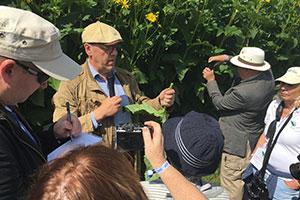By: Melissa Kessler, U.S. Grains Council Director of Communications
What is sustainability? And how do we know when we have achieved it – if it is even something that can be declared “achieved” in a field quite literally evolving all the time?
Those were the central questions for the more than 175 agriculture-focused journalists and communicators from more than 30 countries who converged last week for the annual conference of the International Federation of Agriculture Journalists (IFAJ) in and around Bonn, Germany.
This was a once-a-year opportunity to meet with these colleagues from around the globe – including several from the United States’ member organization, the American Agriculture Editors’ Association – and engage in this conversation, offering the U.S. Grains Council’s (USGC’s) perspective on the theme of sustainability and, more importantly, hearing the experiences and questions of my fellow attendees.
USGC engages on sustainability at home by participating in the U.S. Sustainability Alliance and Field to Market and, as an international market development organization, we understand the need to be able to tell our customers overseas what they want to know about how their feed grains are produced.
What I observed last week traveling with the group of global communicators trying to nail down messages to take home to their farmers is that, much like here in the U.S., this topic continues to provide more questions than answers.
Is sustainability something that has always been inherent in farming or is it something we must now embrace in the wake of climate change? Is it environmental, economic, social, even political? Is it a matter for individual farmers or for the vast systems of agriculture, transportation, energy and food production? Should it be regulated or incentivized by government programs? Is it about farming and farmers at all or is it, as one farmer we spoke with said, “something politicians and organizations concern themselves with”?
While some of these answers were as elusive to the journalists as they are to those who read their reporting, three days of peppering farmers, company representatives and officials with questions provided insight into how we should communicate on sustainability.
First, what people refer to as “agriculture” is so broad, an individual or organization can be very engaged and still lack knowledge about the latest technology used by another sector or the regulations under which farmers of a different cropping system operate.
While it’s a safe bet that every journalist in attendance at IFAJ 2016 has livestock production in their countries, not everyone knew the basics of feed or feed grains production practices, much less the grain trade. Perhaps because we were in Europe, there were few mentions of genetically modified crops, even though they are shown to reduce overall inputs and increase overall productivity. So opportunities for information exchange even among colleagues are critical.
When working to have conversations with different stakeholder groups, we also have be sure the data, messages and tactics we use are relevant to the people with whom we are talking. In half a day’s time, I was able to talk to a government sector communicator from Zimbabwe providing basic ag education and another from Spain offering sophisticated, specific information to established ag producers.
USGC’s long history in market development has taught how critical it is to adapt the same basic themes by commodity, region, culture and market concerns. Sustainability is now clearly now part of this calculus for both our programs and our communications.
And, while any conclusions drawn about “sustainability” will necessarily involve facts and data, the heat behind the dialogue clearly comes from the heart. Good-actor farmers want their land to continue to be fertile; most people want everyone to have a basic quality of life and enough to eat; we all want to do right by our kids.
Consumers care, farmers care and those of us who work for farmers care. That tends to make the conversation – and the action items that those conversations produce – higher stakes and, if we do it right, higher reward.
So while questions clearly abound on this and many other topics of importance to the U.S. grain industry, the conversation about sustainability we had last week also offered a reminder of tenets of good communication across the board: choose your audience carefully, ensure you are meeting their needs and offer information they can relate to both logically and emotionally.


